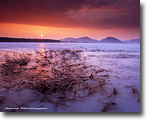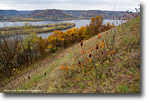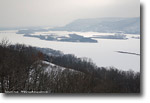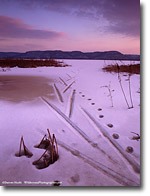|
Mention the Midwest to most folks (photographers included) and their eyes glaze over as they picture flatland, farms, and utter boredom. The Midwest is some place to drive or fly across on your way to the Rockies or California (but not photograph). Well, let those folks go, because that means you can have the Upper Mississippi River to yourself!
The Upper Mississippi River country is anything but flat and boring. No, it is not the wilds of Death Valley. This is, after all, the very settled Midwest. But donít let that fool you. This gem of an area might not be well known, it but has some great scenery and wonderful photographic opportunities. There is a breathtaking landscape of bluffs along a clear young river. There is a great waterfowl migration. There are some of the best concentrations of bald eagles anywhere. There is vibrant fall color. There is easy access to many parks, wildlife refuges, and preserves. In short, there is everything a photographer could want in a destination.
Scenic Landscape and Wildlife
The Upper Mississippi River is steep hill and bluff country. Glaciers may have flattened most of the Midwest but this part avoided it (geologists call it the Driftless area). After the glaciers receded, the river carved through it creating a landscape of bluffs, coulees, and mountains.
The mighty Mississippi starts far up in the north woods and winds through Minnesota. South of the Twin Cities it enters into the bluff country that runs for some 200 miles to Dubuque, Iowa. Along this stretch, the Mississippi and several tributaries such as the Chippewa, Black, and Whitewater Rivers have carved steep valleys and sheer bluffs that give the whole area a topography that is far different that the rest of the Midwest.
The bluff country area touches four states - Minnesota, Wisconsin, Iowa, and Illinois. The river has carved deep through this region and the bluffs approach 600-feet tall near Winona, Minnesota. Expect to find a landscape of hills, bluff, forest, farms, marsh, and rivers. The waters run clear and cold here until winter when they freeze over. There are numerous islands, sloughs, marshes, and backwaters along the Mississippi. There is also thick bottomland full of braided streams and big trees. This is a place you can take time and explore to make some great landscape images.
It is a place you can make some great wildlife images, as well. The combination of farms, along with areas of public lands, means you have a pretty good chance to photograph deer, fox, and assorted other animals (I saw a bear in Banning State Park along the St. Croix River). The river is part of the Mississippi flyway that, twice a year, sees large migrations of waterfowl. It is not uncommon to have several hundred or more geese on a pond. The Upper Mississippi River is also the wintering area for hundreds of bald eagles. The eagles seek open, unfrozen waters to fish from and that means the area around Wabasha, Minnesota (naturally unfrozen stretch of river) or at the base of the Corps of Engineers dams are places you can see dozens of birds an hour.
Access
This is an area that has easy access. You have a world-class airport in Minneapolis-St. Paul (MSP) that is a direct flight from any major US city. There are numerous roads, towns, motels, campgrounds, and parks to give you plenty of possibilities to get around. There are many state parks, wildlife refuges, preserves, and even a national monument along the river to visit, hike, photograph and explore.
Sights To See
There are many sights worth visiting and photographing along the Upper Mississippi River. Just driving the Great River Road can lead to many photo opportunities. Here are a few of my favorite photography locations that you will find along the way.
Lake Pepin - A natural lake on the Mississippi, where the Chippewa River flows in just north of Wabasha, Minnesota. The Chippewa runs fast and is very sandy (think Aldo Leopoldís ďA Sand County Almanac") and that fast sandy flow creates a large natural lake. As the waters exit the lake, they flow fast enough to stay ice free in the winter. A scenic lake year round with great bald eagle viewing in the winter.
Perrot State Park near Trempealeau, Wisconsin - "Mountains" that were once part of the bluff on the Minnesota side of the river but the river cut them off and are now "mountains" in Wisconsin. This is one of the narrowest spots on the Mississippi River. Great hiking trails, bluffs and river views. It is a great year-round destination for photography.
Effigy Mounds National Monument in northeast Iowa preserves a stretch of wooded bluffs and several animal shaped Indian burial mounds on top of the bluffs.
Van Loon Wildlife area near Trempealeau, Wisconsin is a thick bottomland where the Black River breaks into several braided streams as it nears the Mississippi.
Most of the entire river is part of the Upper Mississippi River National Wildlife Refuge meaning most of the islands and backwaters are public land. A boat or canoe opens up a lot of possibilities here to explore.
Several areas in the side river valleys and coulees, such as Wildcat Mountain State Park in Wisconsin and Whitewater State Park in Minnesota, are also very scenic and worth your time for the scenery they offer.
The Seasons
Summers are mild but can be humid and the mosquitoes can be bad. Bring a bug jacket and some repellent.
Fall brings cool, crisp temps and a great display of fall color in early to mid October. The most vivid color seems to happen right before Columbus Day when the waterfowl pass though heading south. It gets cold and gray in November and the river usually freezes over right after Thanksgiving.
Winter can bring deep snow but offers up some wonderful frozen landscapes (plus eagles). But be prepared to handle temperatures that can drop to 25-below zero. Good winter gear (boots, hat, gloves, jackets with hoods, etc.) is a must here. The river breaks up in March when the snow starts to slowly melt and the waterfowl arrive to mark the rebirth of spring.
Spring is a tough season here, as the river is often muddy and the temperatures are winter-like well into late April. If you can catch the flowers, consider yourself lucky, but be prepared for a lot of rain and temp swings.
My ideal times to visit would be the Sept-Oct timeframe (for late summer and fall colors) and then the depth of winter in January.
The Upper Mississippi is a place to put on your photography ďto do list, but just do not tell too many people.
Useful Links
Upper Mississippi River NWR http://www.fws.gov/midwest/UpperMississippiRiver
Wisconsin Department of Natural Resources http://www.dnr.state.wi.us/org/land/parks/specific/findapark.html
Minnesota Department of Natural Resources http://www.dnr.state.mn.us/state_parks/map.html
Comments on NPN nature photography articles? Send them to the editor.
Darren Huski is a landscape photographer from Fort Worth, Texas. He photographs the Lone Star State and throughout the American west and midwest. His work can be seen at www.WildernessPhotographer.net. Darren also blogs about his travels with a large format camera which can be followed at http://thetravelingcamera.blogspot.com.




